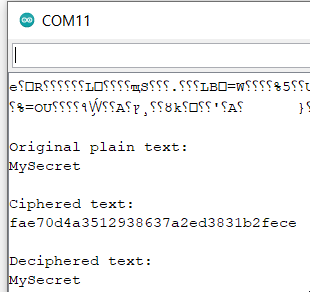Encryption
AES stands for Advanced Encryption Standard and it is a cryptographic symmetric cipher algorithm that can be used to both encrypt and decrypt information.
ince we may want to encrypt data larger than 128 bits, we need to choose a block mode. In our case, we are going to use ECB (Electronic Code Book), which uses the same unaltered key to encrypt each block of plain text.
Example
Demo to demonstrate to encrypt and decrypt data with AES-128 in ECB mode.
1
2
3
4
5
6
7
8
9
10
11
12
13
14
15
16
17
18
19
20
21
22
23
24
25
26
27
28
29
30
31
32
33
34
35
36
37
38
39
40
41
42
43
44
45
46
47
48
49
50
51
52
53
54 | #include "mbedtls/aes.h"
void encrypt(char * plainText, char * key, unsigned char * outputBuffer){
mbedtls_aes_context aes;
mbedtls_aes_init( &aes );
mbedtls_aes_setkey_enc( &aes, (const unsigned char*) key, strlen(key) * 8 );
mbedtls_aes_crypt_ecb( &aes, MBEDTLS_AES_ENCRYPT, (const unsigned char*)plainText, outputBuffer);
mbedtls_aes_free( &aes );
}
void decrypt(unsigned char * chipherText, char * key, unsigned char * outputBuffer){
mbedtls_aes_context aes;
mbedtls_aes_init( &aes );
mbedtls_aes_setkey_dec( &aes, (const unsigned char*) key, strlen(key) * 8 );
mbedtls_aes_crypt_ecb(&aes, MBEDTLS_AES_DECRYPT, (const unsigned char*)chipherText, outputBuffer);
mbedtls_aes_free( &aes );
}
void setup() {
Serial.begin(115200);
char * key = "abcdefghijklmnop";
char *plainText = "MySecret";
unsigned char cipherTextOutput[16];
unsigned char decipheredTextOutput[16];
encrypt(plainText, key, cipherTextOutput);
decrypt(cipherTextOutput, key, decipheredTextOutput);
Serial.println("\nOriginal plain text:");
Serial.println(plainText);
Serial.println("\nCiphered text:");
for (int i = 0; i < 16; i++) {
char str[3];
sprintf(str, "%02x", (int)cipherTextOutput[i]);
Serial.print(str);
}
Serial.println("\n\nDeciphered text:");
for (int i = 0; i < 16; i++) {
Serial.print((char)decipheredTextOutput[i]);
}
}
void loop() {}
|
OUTPUT

